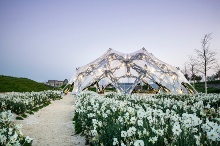BUGA FIBRE PAVILION
Bundesgartenschau, Heillbronn, 2019
Embedded in the wavelike landscape of the Bundesgartenschau grounds, the BUGA Fibre Pavilion offers visitors an astounding architectural experience and a glimpse of future construction. It builds on many years of biomimetic research in architecture at the Institute for Computational Design and Construction (ICD) and the Institute for Building Structures and Structural Design (ITKE) at the University of Stuttgart.
The pavilion demonstrates how combining cutting-edge computational technologies with constructional principles found in nature enables the development of truly novel and genuinely digital building systems. The pavilion’s load-bearing structure is robotically produced from advanced fibre composites only. This globally unique structure is not only highly effective and exceptionally lightweight, but it also provides a distinctive yet authentic architectural expression and an extraordinary spatial experience.
NOVEL COMPOSITE BUILDING SYSTEM INSPIRED BY NATURE
In biology most load-bearing structures are fibre composites. They are made from fibres, as for example cellulose, chitin or collagen, and a matrix material that supports them and maintains their relative position. The astounding performance and unrivalled resource efficiency of biological structures stem from these fibrous systems. Their organisation, directionality and density is finely tuned and locally varied in order to ensure that material is only placed where it is needed.
The BUGA Fibre Pavilion aims to transfer this biological principle of load-adapted and thus highly differentiated fibre composite systems into architecture. Manmade composites, such as the glass- or carbon-fibre-reinforced plastics that were used for this building, are ideally suited for such an approach because they share their fundamental characteristics with natural composites.
The project builds on many years of biomimetic research at the Institute for Computational Design and Construction (ICD) and the Institute for Building Structures and Structural Design (ITKE). It shows how an interdisciplinary exploration of biological principles together with the latest computational technologies can lead to a truly novel and genuinely digital fibre composite building system. Only a few years ago, this pavilion would have been impossible to design or build.
PEER-REVIEWED PUBLICATIONS
2024
- Kannenberg, F., Zechmeister, C., Gil Pérez, M., Guo, Y., Yang, X., Forster, D., Hügle, S., Mindermann, P., Abdelaal, M., Balangé, L., Schwieger, V., Weiskopf, D., Gresser, G. T., Middendorf, P., Bischoff, M., Knippers, J., & Menges, A. (2024). Toward reciprocal feedback between computational design, engineering, and fabrication to co-design coreless filament-wound structures. Journal of Computational Design and Engineering, 11(3), Article 3. https://doi.org/10.1093/jcde/qwae048
2023
- Gil Pérez, M. (2023). Integrative structural design of non-standard building systems: coreless filament-wound structures as a case study (Vol. 49) [Dissertation, Institut für Tragkonstruktionen und Konstruktives Entwerfen, Universität Stuttgart]. https://doi.org/10.18419/opus-12879
- Gil Pérez, M., & Knippers, J. (2023). Integrative Structural Design of Non-Standard Building Systems: Bridging the Gap between Research and Industry. Technology Architecture + Design, 7:2, 244–260. https://doi.org/10.1080/24751448.2023.2246801
2022
- Gil Pérez, M., Zechmeister, C., Menges, A., & Knippers, J. (2022). Coreless filament-wound structures: toward performative long-span and sustainable building systems. In S. Xue, J. Wu, & G. Sun (Eds.), Proceedings of IASS Annual Symposia 2022: Innovation, Sustainability and Legacy (Vol. 2022, pp. 3366–3376). International Association for Shell and Spatial Structures (IASS).
- Guo, Y., Gil Pérez, M., Serhat, G., & Knippers, J. (2022). A design methodology for fiber layup optimization of filament wound structural components. Structures, 38, 1125--1136. https://doi.org/10.1016/j.istruc.2022.02.048
- Menges, A., Kannenberg, F., & Zechmeister, C. (2022). Computational co-design of fibrous architecture. Architectural Intelligence, 1(1), Article 1. https://doi.org/10.1007/s44223-022-00004-x
2021
- Bodea, S., Zechmeister, C., Dambrosio, N., Dörstelmann, M., & Menges, A. (2021). Robotic coreless filament winding for hyperboloid tubular composite components in construction. Automation in Construction, 126, 103649. https://doi.org/10.1016/j.autcon.2021.103649
- Gil Pérez, M., Rongen, B., Koslowski, V., & Knippers, J. (2021). Structural design assisted by testing for modular coreless filament-wound composites: The BUGA Fibre Pavilion. Construction and Building Materials, 301, 124303. https://doi.org/10.1016/j.conbuildmat.2021.124303
2020
- Bodea, S., Dambrosio, N., Zechmeister, C., Gil-Perez, M., Koslowski, V., Rongen, B., Doerstelmann, M., Kyjanek, O., Knippers, J., & Menges, A. (2020). BUGA Fibre Pavilion: Towards Robotically-Fabricated Composite Building Structures. Fabricate 2020: Making Resilient Architecture, 234--243.
- Gil Pérez, M., Rongen, B., Koslowski, V., & Knippers, J. (2020). Structural design, optimization and detailing of the BUGA fibre pavilion. International Journal of Space Structures, 0(0), Article 0. https://doi.org/10.1177/0956059920961778
- Zechmeister, C., Bodea, S., Dambrosio, N., & Menges, A. (2020). Design for Long-Span Core-Less Wound, Structural Composite Building Elements. In C. Gengnagel, O. Baverel, & J. Burry (Eds.), Proceedings of the Design Modelling Symposium, Berlin 2019 (pp. 401--415). Springer International Publishing. https://doi.org/10.1007/978-3-030-29829-6_32
2019
- Dambrosio, N., Zechmeister, C., Bodea, S., Koslowski, V., Gil Pérez, M., Rongen, B., Knippers, J., & Menges, A. (2019). Buga Fibre Pavilion: Towards an architectural application of novel fiber composite building systems. In K. Bieg, D. Briscoe, & C. Odom (Eds.), Acadia 2019: Ubiquity and Autonomy, proceedings of the 39th Annual Conference of the Association for Computer Aided Design in Architecture, Texas (pp. 140--149). Acadia Publishing Company.
- Gil Pérez, M., Dambrosio, N., Rongen, B., Menges, A., & Knippers, J. (2019). Structural optimization of coreless filament wound components connection system through orientation of anchor points in the winding frames. In C. Lazaro, K.-U. Bletzinger, & E. Onate (Eds.), Proceedings of the IASS Annual Symposium 2019 – Structural Membranes 2019 Form and Force (Vol. 2019, pp. 1381--1388). International Association for Shell and Spatial Structures (IASS).
- Kyjanek, O., Al Bahar, B., Vasey, L., Wannemacher, B., & Menges, A. (2019). Implementation of an Augmented Reality AR Workflow for Human Robot Collaboration in Timber Prefabrication. Proceedings of the 36th International Symposium on Automation and Robotics in Construction, ISARC 2019, 1223--1230. https://doi.org/10.22260/ISARC2019/0164
OTHER PUBLICATIONS
2020
- Menges, A. (2020). BUGA Fiber Pavilion 2019. A+u, 20:04(595), Article 595.
- Menges, A., Knippers, J., Wagner, H. J., & Zechmeister, C. (2020). Pilotprojekte Für Ein Integratives Computerbasiertes Planen Und Bauen. In M. Bischoff, M. von Scheven, & B. Oesterle (Eds.), Baustatik - Baupraxis 14: Institut für Baustatik und Baudynamik (pp. 67--79). University of Stuttgart.




